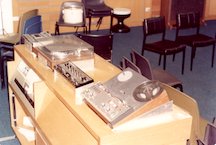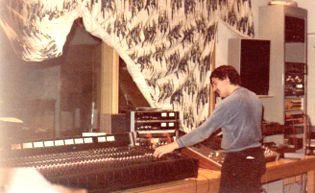Melbourne State College Music Department
| Home Tim Robinson Tim History Art Media Services Films Video Information Requests |
The Melbourne State College Music Department
This is just some of the things that I was involved with as
part of my job as Technical Officer with the Department of
Music and also as Recording Engineer and Technician with the
Electronic Music Studio. I built and installed the equipment
below.This was in the heady days of the mid 1970's where digital technology was only a dream and all things electronic were analog in nature. The following is a snapshot of what was available in the newly opened Department of Music within the Melbourne State College [as it was known then] to the enrolled students.
Facilities available to students and staff were many and varied. The main classrooms had a console which could play all available types of recordings at the time [this is a few years before CD's became available].
 |
 |
| Equipment Installed in
a Student Listening Room There was a cassette player, Reel to Reel tape recorder, amplifier and turntable. Students were often supplied with 'listening tapes' which they could utilise this space to hear if they did not have access available at home. |
One of Four Consoles
Set Up in the Lecture Rooms Lecturers were able to replay material from a number of different sources including Reel to Reel, Cassette tape and disk. |
The Electronic Music Studio was developed over a number of years and initially has two Putney VCS3 synthesisers and was later upgraded with more analogue synth gear made by the Roland Corporation. The facilities available to students also consisted of a recording studio which was initially set up with a 4 track reel to reel tape recorder so as to be able to do "Quadraphonic" [4 channel] Sound, which was becoming a 'thing' but eventually petered out as it was just to difficult to manage and there were problems with 4 channel vinal records* which were never properly solved.
* 4 Channel recording to
disk involved a complicated system of record cutting
which involved using a sub-carrier to provide the
additional two channels which was superimposed on the
stereo tracks. It only worked correctly on the best of
systems which had components that could read this
additional information. There was also a lack of proper
4 channels recordings. The system also required 4
speakers - two additional 'rear' speakers - in addition
to the 'front' speakers and a new amplifier for most
people and was just too complicated to set up. It
eventually had a natural death and was missed by
nobody!!.
 |
 |
| Original 4 track
quadraphonic mixer designed and built by myself. It
was used for a number of years before the studio was
upgraded to an 8 channel system with a new mixer. |
The Tascam M15 mixer
which took over from the one on the left. From left
to right, Tascam 8 track reel to reel [1/2" tape].
Tascam 24channel in, 8 channel out mixer. DBX
compressor limiters, Revox 2 track and Sony 4 track
tape recorders. |
The Electronic Music Studio was set up to the left of the mixing equipment shown above so it had multi track recording available in addition to the syntesisers. Again, a number of specialist 'boxes' were built to allow the filtering and distortion of various sound to create what was known at the time as 'Electronic Music'. It was all analogue equipment and needed a basic understanding of electronics to set up. This was mase a little simpler with the introduction of the VCS3 Synthesiser - made famous by its use by Pink Floyd on their album 'Dark Side of the Moon'.
 |
 |
 |
| Roland SH-3
Synthesiser |
Oscillator bank on the
Roland Synthi 100 series. |
Left to right - Reel
to reel tape recorders, Putney VCS3 synthesisers
with 8 in 4 out mixer in between and patch panel. |
Other units in the EMS [Electronic Music Studio] were ring modulators [think Doctor Who voice!], reverb units and various filters. These all connected to the patch panel in the left photo above. Asyou can see this was a state of the art studio at the time featuring some of the latest equipment available [that an educational institution could afford]. Most of this was dismantled when the College was eventually taken over by the University of Melbourne. It is iunfortunate that Music students these days are almost ignorant of the history of analogue synthesisers.
[ Top
of Page | Tim
Robinson | Art
Media Services |
Cooking | Film
and Video]
|
| Published by
Art Media Services Last Updated: September9 2024 |